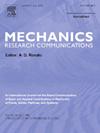Early traces of the principle of virtual work in Hellenistic texts: Exegesis of problems 1, 2 and 3 in pseudo-Aristotle’s Mechanica Problemata
IF 2.3
4区 工程技术
Q3 MECHANICS
引用次数: 0
Abstract
Our aim is to try to trace, in the history of mechanics, the first formulation of the principle of virtual work (PVW). This important question is, of course, connected with the origin of the concept of kinematics and its relation with the concept of dynamics. Now it is widely accepted that the Principle of Virtual Velocities (later called Virtual Work) was known in a geometrical form by the author of the Greek text Mechanica Problemata (The Mechanical Problems). Indeed, this text does not appear to be a theoretical treatise but rather a collection of solved exercises, mainly concerning statics, the functioning of machines and some dynamics. In this paper we present our exegesis of the first three problems of the Mechanica Problemata, because we believe that deeply understanding its content may allow us to clarify the Greek origin of the Principle of Virtual Work, to locate in space and time the birth of mathematized mechanics and to prove that Renaissance mechanics derives from Greek sources.
希腊文本中虚功原理的早期痕迹:伪亚里士多德的《力学问题》中问题1、2和3的注释
我们的目的是试图追溯,在力学的历史上,虚功原理(PVW)的第一个公式。当然,这个重要的问题与运动学概念的起源及其与动力学概念的关系有关。现在,人们普遍认为虚速度原理(后来被称为虚功)是由希腊文《机械问题》的作者以几何形式提出的。事实上,这篇文章看起来并不是一篇理论论文,而是一个解决习题的集合,主要涉及静力学,机器的功能和一些动力学。在本文中,我们对《力学问题》的前三个问题进行了注释,因为我们相信,深入理解它的内容可以让我们澄清虚功原理的希腊起源,在空间和时间上定位数学化力学的诞生,并证明文艺复兴时期的力学起源于希腊。
本文章由计算机程序翻译,如有差异,请以英文原文为准。
求助全文
约1分钟内获得全文
求助全文
来源期刊
CiteScore
4.10
自引率
4.20%
发文量
114
审稿时长
9 months
期刊介绍:
Mechanics Research Communications publishes, as rapidly as possible, peer-reviewed manuscripts of high standards but restricted length. It aims to provide:
• a fast means of communication
• an exchange of ideas among workers in mechanics
• an effective method of bringing new results quickly to the public
• an informal vehicle for the discussion
• of ideas that may still be in the formative stages
The field of Mechanics will be understood to encompass the behavior of continua, fluids, solids, particles and their mixtures. Submissions must contain a strong, novel contribution to the field of mechanics, and ideally should be focused on current issues in the field involving theoretical, experimental and/or applied research, preferably within the broad expertise encompassed by the Board of Associate Editors. Deviations from these areas should be discussed in advance with the Editor-in-Chief.

 求助内容:
求助内容: 应助结果提醒方式:
应助结果提醒方式:


